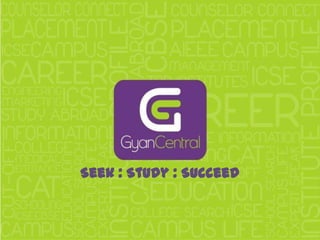
Introduction to indian navy education branch
- 1. Seek : Study : Succeed
- 2. Introduction to Indian Navy Education Branch
- 3. Officers in the education branch are responsible for training of naval officers and sailors in different branches. Short Service Commission is for 10 years and is expendable unto 14 years. Education Officers play a major role in the training of a naval officer/sailor. Education Officers are responsible for scientific and methodical instructions including theoretical aspects of technical subjects of all branches of the Navy and for general education. Additionally, an Education Officer can specialize in oceanography and meteorology and also in some of the specializations of the Executive Branch. Just as the Navy is constantly updating its technology, the technical education of its officers and men must also keep pace being an optimally effective force. Any service will be as good as the training its officers and men receive. Education Officers play a very major role in the total training of a Naval Officer/Sailor. They are responsible for scientific and methodical instructions including theoretical aspects of technical subjects of all branches of the Navy and for general education, both ashore and afloat. They can additionally specialize in Oceanography and Meteorology and also in any of the specializations of the General Service, Executive Branch.
- 4. Law Officer: A separate cadre of Law Officers deals with the legal needs of the Navy. Law officers advise on evidence in court martial and other disciplinary actions and give legal advice to naval staff in various civil matters Selection Procedure: Indian Navy conducts a selection process for recruitment as Short Service Commissioned (SSC) Officers in education branch of Indian Navy. The hiring process takes place as the need arises and the requirements are advertised in the newspapers. Eligibility Criteria: Candidate must be between 21 to 25 years of age as on 1st July, 2010. Also the candidate should have a Master's degree in Physics/Mathematics with at least 55% aggregate marks. Candidates having Master's in Physics should have had Maths in BSc and candidates having Master's in Maths should have had Physics in BSc. Women candidates having Chemistry with Physics as a subsidiary subject at degree level can also apply. The candidates who will be in the final round of admission should be free from any kind of mental as well as physical trauma. Exposure to such threats at the time of final admission will result in direct termination of the recruitment of that particular candidate.
- 5. Physical Requirement: Male candidates should have a minimum height of 157 cms with correlated weight, leg length, sitting height and thigh length and female candidates should have a minimum height of 152 cms and correlated weight minimum being 38.6 kilogram. Eye Sight: The minimum acceptable vision standard for distant vision is 6/60, 6/60 correctable to 6/6, 6/6. Candidate should not be colour/night blind. Application procedure: Candidates can either send a handwritten/typed application form (on an A4 size paper) according to the format given in the admission notification or download the application form from the website www.nausena-bharti.nic.in . The candidates are advised to go through each and every instruction with full care and concentration, before applying. The candidates have to send the filled application form along with attested copies of 10th Class pass Certificate and other educational certificates as required to mentioned address. The Examination Committee will review the application form and reply the candidates with an admit card in the permanent address as per provided by the candidates itself.
- 6. Selection Procedure: Candidates are shortlisted on the basis of their performance in qualifying exam. Shortlisted candidates are called for SSB Interviews. Candidates who clear SSB Interviews will have to appear in Aviation medical examination before being selected.
- 7. www.gyancentral.com Medical - http://gyancentral.com/articles/graduate/medical AIEEE - http://gyancentral.com/articles/graduate/engineering/engineering-entrance-exams/all-india-engineering-entrance-exam Aviation - http://gyancentral.com/articles/others/aviation Engineering - http://gyancentral.com/articles/graduate/engineering Commerce - http://gyancentral.com/articles/graduate/commerce Medical - http://gyancentral.com/articles/graduate/medical Science - http://gyancentral.com/articles/graduate/science Animation - http://gyancentral.com/articles/others/animation Clinical Research - http://gyancentral.com/articles/others/clinical-research Hotel Management - http://gyancentral.com/articles/others/hotel-management Media - http://gyancentral.com/articles/others/media Fashion Designing - http://gyancentral.com/articles/others/fashion-designing MBA - http://gyancentral.com/articles/post-graduate/mba IIT - http://gyancentral.com/articles/graduate/engineering/indian-institutes-of-technology CAT - http://gyancentral.com/articles/post-graduate/mba/mba-entrance-exams/mba-entrance-tests Media - http://gyancentral.com/articles/others/media
